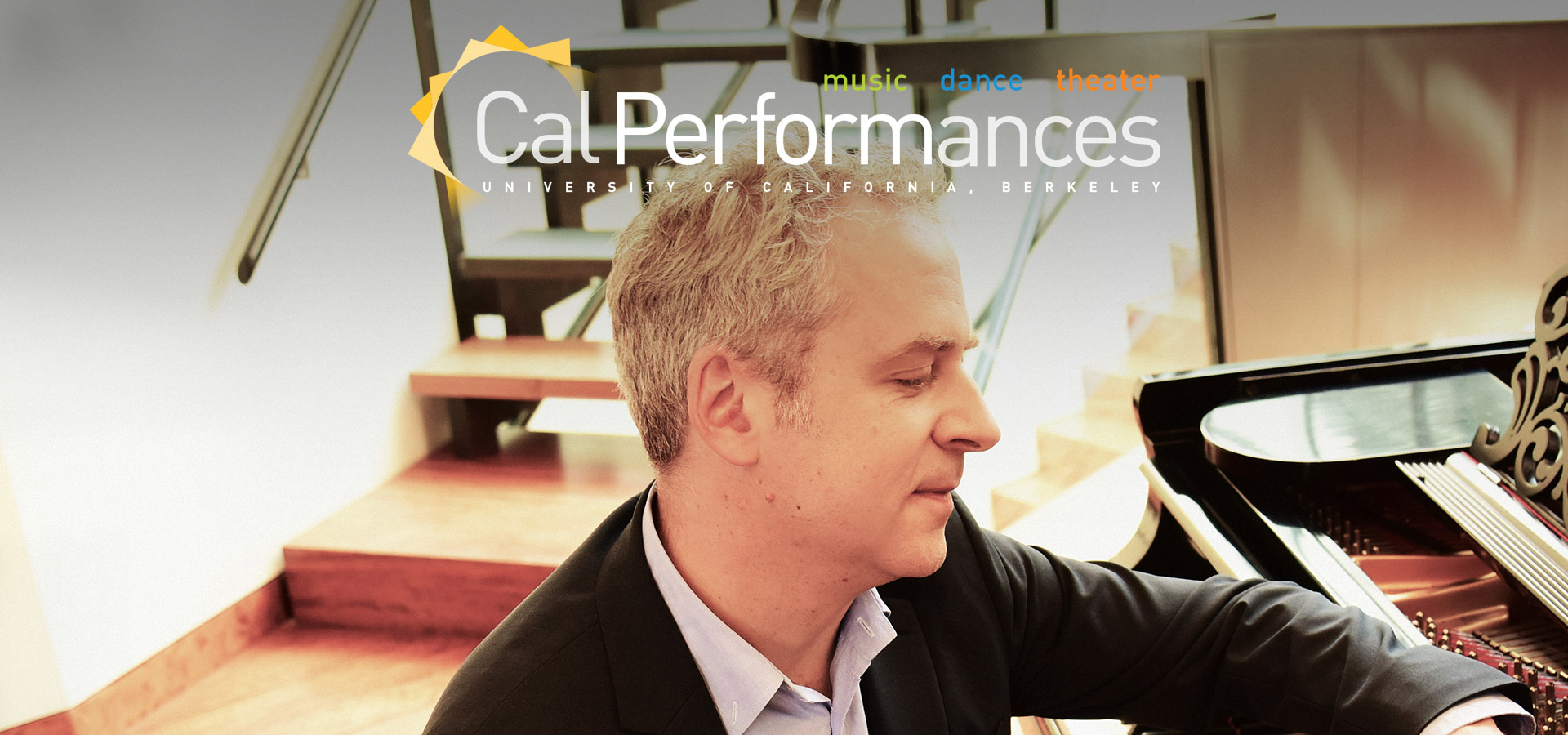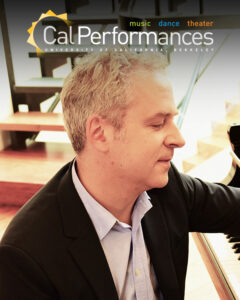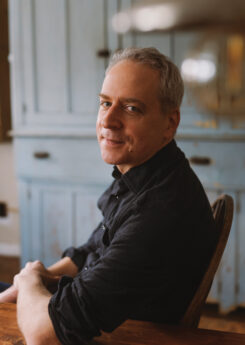Jeremy Denk, piano
Sunday, February 12, 2023, 3pm
Hertz Hall
This performance is made possible, in part, by Jeffrey MacKie-Mason & Janet Netz.
From the Executive and Artistic Director

We move now into the busiest time of the year at Cal Performances, with a schedule that offers a nearly nonstop celebration of the very finest in the performing arts.
This month alone, we welcome our great friends at the Mark Morris Dance Group for the Bay Area premiere of Morris’ latest, The Look of Love, a fresh and heartfelt homage to the chart-topping songs of Burt Bacharach. We’ll also hear classical masterworks from audience favorites, cellist David Finckel and pianist Wu Han; a particularly far-ranging concert from the extraordinary pianist Jeremy Denk; well-loved solo works by J.S. Bach coupled with new compositions by the best and brightest voices in contemporary music from the insightful young violinist Alexi Kenney; and a bold selection of new music by UC Berkeley composers from the university’s own Eco Ensemble.
Add to that performances with Kodo, Japan’s ever-popular and soul-stirring taiko drummers; an evening with NPR’s Ira Glass sharing new stories and reflections from his decades-long career; an afternoon conversation with the legendary Rita Moreno discussing her fascinating life in Hollywood; and a rousing program with the virtuosic dancers of Washington DC’s celebrated Step Afrika! troupe as it continues and extends the long tradition of stepping—elaborate and joyful song and dance rituals performed by Black fraternities and sororities since the early 1900s.
And that’s just our schedule for February. In March, two events deserve special attention: the return of the legendary Vienna Philharmonic Orchestra under conductor Christian Thielemann (making his Bay Area concert debut), and the US premiere of revered South African artist William Kentridge’s astonishing new SIBYL (part of a major campus-wide residency with this singular artist; for more, see Thomas May’s excellent article on Kentridge, beginning on the next page).
Upcoming Illuminations programming will continue to take advantage of Cal Performances’ unique positioning as a vital part of the world’s top-ranked public university. As we’ve done all season long, we’ll be engaging communities on and off campus to examine the evolution of tools such as musical instruments and electronics, the complex relationships between the creators and users of technology, the possibilities enabled by technology’s impact on the creative process, and questions raised by the growing role of artificial intelligence in our society.
This concept of “Human and Machine” has never been so pertinent to so many. Particularly over the course of the pandemic, the rapid expansion of technology’s role in improving communication and in helping us emotionally process unforeseen and, at times, extraordinarily difficult events has made a permanent mark on our human history. Throughout time, our reliance on technology to communicate has—for better and worse—influenced how we understand others as well as ourselves. During this Illuminations season, we will investigate how technology has contributed to our capacity for self-expression, as well as the potential dangers it may pose.
Some programs this season will bring joy and delight, and others will inspire reflection and stir debate. We are committed to presenting this wide range of artistic expression on our stages because of our faith in the performing arts’ power to promote empathy. And it is because of our audiences’ openness and curiosity that we have the privilege of bringing such thought-provoking, adventurous performances to our campus. The Cal Performances community wants the arts to engage in important conversations, and to bring us all together as we see and feel the world through the experiences of others.
Please make sure to check out our brochures and our website for complete information about upcoming events. We can’t wait to share all the details with you, in print and online.
Thank you for joining us at Cal Performances!
Jeremy Geffen
Executive and Artistic Director, Cal Performances
 We move now into the busiest time of the year at Cal Performances, with a schedule that offers a nearly nonstop celebration of the very finest in the performing arts.
We move now into the busiest time of the year at Cal Performances, with a schedule that offers a nearly nonstop celebration of the very finest in the performing arts.
This month alone, we welcome our great friends at the Mark Morris Dance Group for the Bay Area premiere of Morris’ latest, The Look of Love, a fresh and heartfelt homage to the chart-topping songs of Burt Bacharach. We’ll also hear classical masterworks from audience favorites, cellist David Finckel and pianist Wu Han; a particularly far-ranging concert from the extraordinary pianist Jeremy Denk; well-loved solo works by J.S. Bach coupled with new compositions by the best and brightest voices in contemporary music from the insightful young violinist Alexi Kenney; and a bold selection of new music by UC Berkeley composers from the university’s own Eco Ensemble.
Add to that performances with Kodo, Japan’s ever-popular and soul-stirring taiko drummers; an evening with NPR’s Ira Glass sharing new stories and reflections from his decades-long career; an afternoon conversation with the legendary Rita Moreno discussing her fascinating life in Hollywood; and a rousing program with the virtuosic dancers of Washington DC’s celebrated Step Afrika! troupe as it continues and extends the long tradition of stepping—elaborate and joyful song and dance rituals performed by Black fraternities and sororities since the early 1900s.
And that’s just our schedule for February. In March, two events deserve special attention: the return of the legendary Vienna Philharmonic Orchestra under conductor Christian Thielemann (making his Bay Area concert debut), and the US premiere of revered South African artist William Kentridge’s astonishing new SIBYL (part of a major campus-wide residency with this singular artist; for more, see Thomas May’s excellent article on Kentridge, beginning on the next page).
Upcoming Illuminations programming will continue to take advantage of Cal Performances’ unique positioning as a vital part of the world’s top-ranked public university. As we’ve done all season long, we’ll be engaging communities on and off campus to examine the evolution of tools such as musical instruments and electronics, the complex relationships between the creators and users of technology, the possibilities enabled by technology’s impact on the creative process, and questions raised by the growing role of artificial intelligence in our society.
This concept of “Human and Machine” has never been so pertinent to so many. Particularly over the course of the pandemic, the rapid expansion of technology’s role in improving communication and in helping us emotionally process unforeseen and, at times, extraordinarily difficult events has made a permanent mark on our human history. Throughout time, our reliance on technology to communicate has—for better and worse—influenced how we understand others as well as ourselves. During this Illuminations season, we will investigate how technology has contributed to our capacity for self-expression, as well as the potential dangers it may pose.
Some programs this season will bring joy and delight, and others will inspire reflection and stir debate. We are committed to presenting this wide range of artistic expression on our stages because of our faith in the performing arts’ power to promote empathy. And it is because of our audiences’ openness and curiosity that we have the privilege of bringing such thought-provoking, adventurous performances to our campus. The Cal Performances community wants the arts to engage in important conversations, and to bring us all together as we see and feel the world through the experiences of others.
Please make sure to check out our brochures and our website for complete information about upcoming events. We can’t wait to share all the details with you, in print and online.
Thank you for joining us at Cal Performances!
Jeremy Geffen
Executive and Artistic Director, Cal Performances
About the Performance
J.S. Bach
Partita in G major, BWV 829
Each of Bach’s keyboard Partitas has a key, of course, but also a personality. The G major is full of play—childlike, often impish, occasionally wicked. But, (like the Goldberg Variations in the same key) it has an effortless way of folding its musical sins into a general beneficence and tenderness, even a divinity. It suggests a revelation I’ve never found in the Bible: that God, at times, could be quite the jokester.
It begins with a snippet of a scale, a few simple chords, and then silence. Silence is rare for Bach, especially so early on. He usually prefers to start up an idea and let it spin out in an inexhaustible engine of invention. But here, right away, a silence—and then yet another, when the initial idea is repeated.
What comes next is an endless, run-on series of scales and arpeggios, going up and then back down, a bit (to my retro mind) like a typewriter chugging from left to right, then swiped back for more. They seem to be innocent scales and chords, but at each turn, Bach hides a dissonance, a little naughtiness. And behind it is the larger, structural joke: after an opening idea that stops too soon, comes a stream of notes that just won’t shut up. As these go on, they accumulate notes (like the proverbial rolling stone) that don’t seem to belong, minor key notes—and again and again these get laughed away or dissolved by the return of the opening idea.
The Allemande, like many Bach Allemandes, starts fairly straightforwardly and then meanders into little knots of musical trouble that it must unravel. It’s only two voices (with an occasional roll to fill things out) and yet harmonically rich: a carpet of consonance scattered with seductive dissonances. In one notable spot, the left hand heads down to the bottom of the keyboard while the right hand sails up. They land on the downbeat together on the most wrong possible pair of notes: A in the bass, B-flat up above. Yikes. And then (by now, we realize, an essential gesture of this Partita) the “mistake” is laughed off and resolved, though not without one or two added dissonances along the way.
If the Allemande winds and wends, the Courante is a bounding flow of notes, mostly perpetual motion. It takes its delicious figuration from an imitation of string playing, of the virtuosity of a bow crossing strings. The first half is a violin solo, but in the second half, the cellist (or gamba player) gets their revenge. In the final bars, violin and cello join in together, leaping off to opposite ends of the keyboard.
The Sarabande’s limpid beauty unfolds in a series of dotted rhythms (short long, short long, short long) which give it a courtly air, and make it feel lighter (and maybe more French) than many other Sarabandes. But this lightness doesn’t preclude depth. Here you feel the many possible ways that Bach can treat dissonances. Some are shocking, melancholy, or strange, and feel like part of a musical “problem”; others, lyrical and comforting, part of the solution. The last phrase, which finds a way to answer the questions raised by all these sentences of music, comes down D C B A G—exactly how the Partita began.
Now comes a minuet that is not a minuet. Or, it seems to forget it’s a minuet until the last bar of each phrase—as if Bach is saying “oh yes, I forgot, a minuet has three beats!” On top of the main rhythmic prank, long passages of dislocation with the right hand playing the wrong number of beats, there is an outrageous little chromatic adventure in the middle—far from what your average courtly person might demand of a minuet.
A witty and elegant Passepied follows, but the climax of this Partita is obviously its final buoyant Gigue, which, like many Bach Gigues, is a fugue. The subject of this fugue has a little silence in its middle—an important reference back to the spirit of the opening movement. The leaping main idea, with a cascade of thirds, alternates with more stepwise interludes, a game of motion that keeps unfolding delights.
But the real surprise awaiting this Gigue is its second half, when Bach introduces a new idea. Three curious leaping notes, a wait, then a little tag which resolves with a trill. The trill seems like one of those obligatory trills with which many fugue subjects (especially the most pedantic ones) try to bring themselves to an end. But no. Bit by bit, the trills start to go haywire, becoming anything but pedantic, seeming to interrupt themselves, almost invading the fugue, getting into every corner, like mice into a cupboard. This is one of those moments when the pianist really misses the special acoustics of the harpischord, the particular rattle that a quilled trill creates.
About midway through the second half, Bach reveals to us his delicious secret: this new weird theme, trills and all, is actually designed to fit perfectly superimposed on the original subject! Of course—we should have guessed. Bach as contrapuntal superhero, once again.
But there’s no time for the keyboardist to savor this ingenuity because the crazy trills keep coming, plus the leaping theme. One last climbing chromatic trill rampage in the tenor voice is followed by an unprecedented Bach act: three octaves in the bass. I’ve often wondered about these octaves, which seem to belong to a different composer or time. It seems like Bach is summoning something, as if the spilling-over dispersion of the fugue requires a serious authority to finally bring down the curtain, and stop the joyful madness.
Franz Schubert
Four Impromptus, D. 935
Many years ago, I accompanied a Schubert violin Sonatina for a lesson with the great pedagogue Josef Gingold. We finished, only to have him say “poor Schubert!” and get lost in thought. He offered little else except a piercing gaze, which meant: think (you happy, young, clueless musicians) about the person whose music you are playing. Beset by disease, endlessly creative but repressed, immersed in a literary-arty Viennese social circle, Schubert is so very different from Mozart or Beethoven. Mozart’s music wants you to see the whole of the social fabric, high and low and in between, comedy and tragedy in a braid: the world is his stage. Beethoven focuses the gaze more towards individual expression, the artist as a idealized hero, lighting the way forward. Schubert (like Beethoven) gives voice to the single artist. But his artist persona is in no way ideal, and gets stuck in loops of depression, like any of us. His protagonists look constantly backward, because forward there never seems to be any hope.
For me, the quintessential Schubert maneuver is to search out a kind of uncanny sadness, an emotion we think we cannot quite bear. But then, once you’re there, Schubert tinkers with something (often just a shift of one or two notes) and digs even deeper, farther into the uncanny. Having gone past the unbearable, Schubert makes himself comfortable. He starts to look around and map out the parts of our minds we’d rather not face.
The first of these four Impromptus starts with an emphatic minor chord. For a little while there is not much to call a melody. A small, haunting, hovering, quivering idea begins—not really a melody either, something drawn seemingly from the Viennese subconscious—which keeps tiptoeing between darkness and a light dance. It gets stormier, erupting into unprecedented fury, but then just as suddenly dies down, and the first of our musical revelations appears.
The quiver now re-emerges as an endless, gentle Viennese melody, with the melody crooning in parallel sixths—a quintessential “singing in harmony” texture. The chords are banal—it’s just a folktune vamp—but Schubert sets up dissonances on each downbeat, and passing melodies between, coloring the cliche, making it both beautiful and heartbreaking. Schubert allows this idea to flourish and echo in the mind. We hear it in one register, then another, and finally a third time with an aura of twinkling faster notes. Basically, Schubert’s version of paradise—as always, poisoned by regret.
A second revelation comes. We are switched back into the minor. A long, extraordinary, minimalist musical paragraph unfolds: little melodic fragments played by the left hand, (endlessly unsatisfied questions and answers) while the right rustles away. We begin in the minor, reach towards the major, and it’s beautiful at first, but it becomes threatening and unstable. Just at the most unstable juncture, a hymnic and gorgeous resolution appears to return us to the original major key. In many composers, such a long-sought arrival might be a triumph or kind of a conversion—sadness transformed into joy. But not here. Paraphrasing Leon Fleisher, Schubert was the composer who figured out how to make the major key sadder than the minor.
The second Impromptu is a simple dance, somewhat slower than a waltz, but also in three: the Viennese Ländler. (You can watch Maria and the Captain dance one in The Sound of Music). Schubert wrote hundreds of these—it was as natural for him as breathing. This one is memorable, despite minimal materials, the kind of ideal tune that Schubert could just pull out of the air. It plays out over a repeated rhythmic pattern…
and one two
and one two
and one two three one
… which is only interrupted for two violent chords. These moments of stoppage have a shocking effect because of the constancy of what surrounds them. What could be a charming, flowing, conventional middle section erupts into distant harmonies and seeming violence. The effect is not that of an actual dance so much as a piece about a dance, using the dance as a symbol of something lost, and an object for meditation.
The third Impromptu is a set of variations on a theme Schubert obviously loved—he used it several times. This is as close as we get to relief or interlude. Clouds peek in, and there is one dark minor variation, but for the most part the music tends towards elegance, towards the salon, allowing the pianist even at times to enjoy being a virtuoso. It calls to mind the famous joke where Germans assess the situation as “serious, but not desperate” while Austrians judge it “desperate but not serious.”
The last Impromptu seems to begin as a swift, witty, swirling folk dance, like a Romani street band might play, but it is curiously prone to anger—wild dynamic contrasts, a pesky dark D-flat. The middle section is consumed with various scales rushing around the keyboard. These scales seem to have little clear goal, except that they keep landing on a repetitive waltz. This waltz also doesn’t seem to know where it’s going, and comes to various abrupt stops, where the animating, driving urge of the piece falters.
Towards the end, Schubert makes clear the original wit of the dance was a trick; the sense of a dance of death deepens. The melody vanishes; we are just listening to chords while the grim rhythm section keeps on. Everything comes to a halt, and you might imagine the piece over. But one last virtuosic passage appears, an unprecedented and charmless outburst, channeling all the earlier latent rage, storming from the top of the keyboard to the bottom. I find this ending powerful, but also inconclusive—like so many Schubert moments, the essence of the effect is that the music is not quite what it wants to be.
Coleridge-Taylor, Wiggins, Joplin-Chauvin, Rzewski
Suite of Four Pieces
This suite owes its existence to both youth and age: to my eager, talented students at the Music Academy of the West, and a newspaper feature by the eminent, deeply generous composer George Lewis. One of my students played the Rzewski “Winnsboro Cotton Mill Blues” and I was struck by what a powerful piece of writing it was, how it marshaled the piano to viscerally conjure a history of violence, and the way it erased (in the best way) the boundaries between “classical” and “popular” music.
Soon after, George Lewis alerted me to a curious and extraordinary piece by “Blind Tom” Wiggins, a blind, autistic, enslaved Black pianist who made his master quite rich in the latter half of the 19th century, touring America as a performing sensation. The piece in question was arguably his most famous work: The Battle of Manassas, a potboiler dramatic piano “musical scene” (with occasional vocal interjections) depicting a glorious Confederate victory, ending with a hectic, disastrous Union retreat. It struck me there was some interesting historical irony to be had, juxtaposing these two pieces in a suite, an enslaved person celebrating his subjugators, and then this piece about the cotton mill, exploitation, and the irrepressible power of the blues in a war against all of it.
Both the Rzewski and Wiggins are quite violent—the Wiggins is astonishingly ahead of its time! It seemed to me the suite would tell a fuller, more satisfying story with some respite. So I summoned two gorgeous, haunting pieces as emblems of other specifically Black musical genres, both of which overthrow conventions of Western music and are absolutely inimitable, in some ways more universal than anything white composers have managed to do: the spiritual and the ragtime. Coleridge-Taylor drapes a spiritual tune in all sorts of Romantic harmonies, in order to hear and rehear the sorrow within. The ragtime of Joplin and Chauvin—two friends and colleagues who never managed to acquire the wealth that their musical gifts and fame deserved—has both the wit and charm of the syncopation, and a sense of tugging nostalgia, like a faded photograph.
Ludwig van Beethoven
Piano Sonata in C minor, Op. 111
You could lazily write a program note about Beethoven’s last Sonata by simply quoting all the beautiful things that have been written about it. There is a thoughtful discussion in Milan Kundera’s Testaments Betrayed, for instance, which I highly recommend reading, and a very famous passage in Thomas Mann’s novel Doctor Faustus, which I absolutely cannot resist quoting:
The arietta theme, destined for adventures and vicissitudes for which, in its idyllic innocence, it seems never to have been born, is immediately called up and for sixteen bars says its piece, reducible to a motif that emerges toward the end of its first half, like a short, soulful cry—just three notes, an eighth, a sixteenth, and a dotted quarter … But what now becomes of this gentle statement, this pensively tranquil figure, in terms of rhythm, harmony, counterpoint, what blessings its master bestows upon it, what curses he heaps upon it, into what darknesses and superilluminations, where cold and heat, serenity and ecstasy are one and the same, he hurls and elevates it …
It’s no accident that Op. 111 attracts literary attention. Though it’s music, it doesn’t quite behave like it. It seems to be charged with meaning, to communicate in symbols, ciphers, clues.
The Conventional Sonata is a suite of movements: say, a serious first movement, a lyrical second, a playful Scherzo, a bouncy Rondo. Here, Beethoven provides just an Allegro and an Adagio, two opposed poles. He whittles everything down to the absolute difference of the two movements, and a chronology: the sweeping away of one thing by another. As with the greatest Beethoven pieces, the structure itself becomes a message: A question is overwhelmed by its answer. By the time the answer is over, the question is more than forgotten; it has been unwoven, made inconceivable.
The first movement begins in the way of solemn first movements, with a majestic introduction in dotted rhythms—conjuring, among other memories, the opening of Beethoven’s Pathétique Sonata, Op. 13. Its first gestures are asymmetrical: We leap into loud, dissonant chords, which are then resolved quietly, almost parenthetically. After the third dissonant declaration comes a digression: Beethoven allows the dotted rhythm to wander into the most distant harmonies, the same rhythm but getting ever quieter, stranger, and farther away, as if in a dream.
The emergence from this dream is violent but odd: It is torn between assertion and hesitation, between dramatic statements and second thoughts. This indecision becomes a theme of the ensuing section (Allegro con brio ed appassionato). The Allegro is mostly consumed with rushing passages, with streams of sixteenth notes—searching, sequencing. But Beethoven scatters tempo slowdowns throughout, of all sizes and shapes. These frictions have a dual meaning. By resisting, they heighten our awareness of a compulsion, a hurrying force; but they also continuously imply an alternative, a world without rushing. The most radical, meaning-laden slowdown happens in the second theme. It’s not a theme, really, more a falling fragment, built on a suspended harmony. Beethoven freezes on its irresolution; he allows it to become a beatific impasse, an Adagio. Then, with a storm of sixteenth notes, the precarious perch is abandoned, the movement’s relentless urge is resumed.
At the last moment, the first movement wavers into the major key—a strange flickering of the tonal sense. In that same sudden, unsettling major, we begin the magical Arietta.
Thomas Mann’s description of the Arietta theme is wrong, weirdly! The main idea (dim-da-da) does not wait to appear until the end of the first phrase. It is the very first thing you hear, this soul of the movement. Much as in the Ligeti Études, Beethoven treats the generative rhythm as a kind of DNA, allowing it to undergo odd mutations, to court chaos. Stripped down to Morse code, the idea is:
long short long … long short long
But in the first variation he chains it together, elides it into:
long short long short long
And then doubles that:
long short long short long short long short long short long
And then doubles that! In the last transformation it becomes amazingly like jazz, with crazed, syncopated dotted rhythms. Of all the profound whiffs of the future Beethoven might have caught, it had to be boogie-woogie?
The evolution from the theme to this proto-jazz has been seamlessly incremental. But looking back at the pure starting point, we might feel that somewhere along the way, we’ve taken a wrong turn. A sequence of extraordinary events ensues, playing on this sense of disorientation. First, the post-boogie-woogie variation dissolves into a haze. The rhythmic outline is lost, diffused in a million starry notes, although the harmonies are proceeding as before. But then this feeling of being lost becomes actual, tangible, as we go off the harmonic track of the theme, into an ecstatic, free C major. The next step is more disturbing: We go off the track of the key, leaving C major for an uncanny E-flat major. The texture thins, evoking an edge, an extenuation. And after this abyss, which seems irrecoverable, lost beyond lost, we become even more lost: Beethoven writes an endless, soft, drifting passage, fragments of the theme over a sequencing quicksand of harmony.
Many times in his life Beethoven pursued the trope of “losing” the right key and finding it again (as if the composer didn’t know the whole time!). It was often a joke, a trick, a clever feint; but not here. Here, for this last Sonata, for this moment of farewell, Beethoven has reserved a harrowing lost-and-found: The theme emerges out of the farthest corner of the labyrinth as if discovered, singing over a stream of harmony, all discontinuities and wanderings forgotten. It is one of the most heartrending passages in the piano literature: an affirmation that says no, no matter what has happened to us, we are not lost. At the climax, Beethoven makes one crucial change: The main idea bursts into a sequence that did not exist in the original theme (but seems as if it had always been meant to be there); he adds continuity to continuity, and allows the generative idea, in Ligeti’s words, to “overflow its banks.”
—Jeremy Denk




